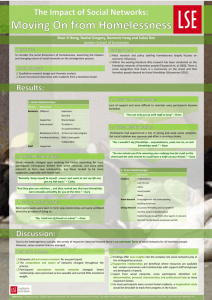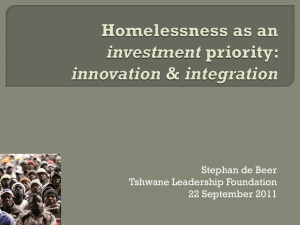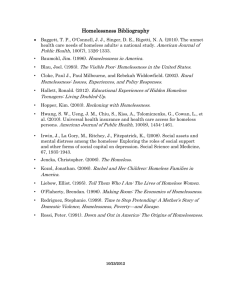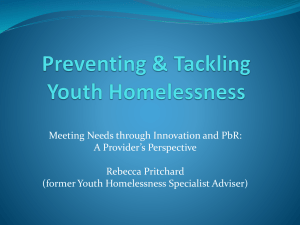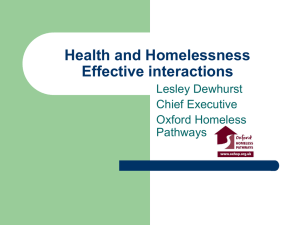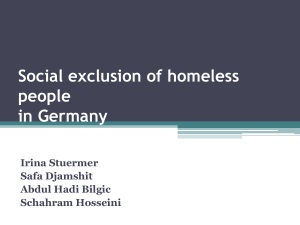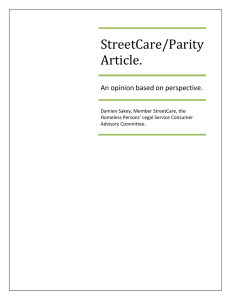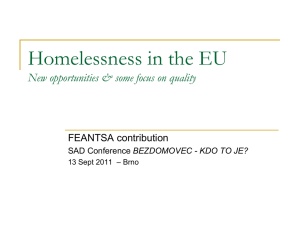The impact of social networks: moving on from homelessness
advertisement
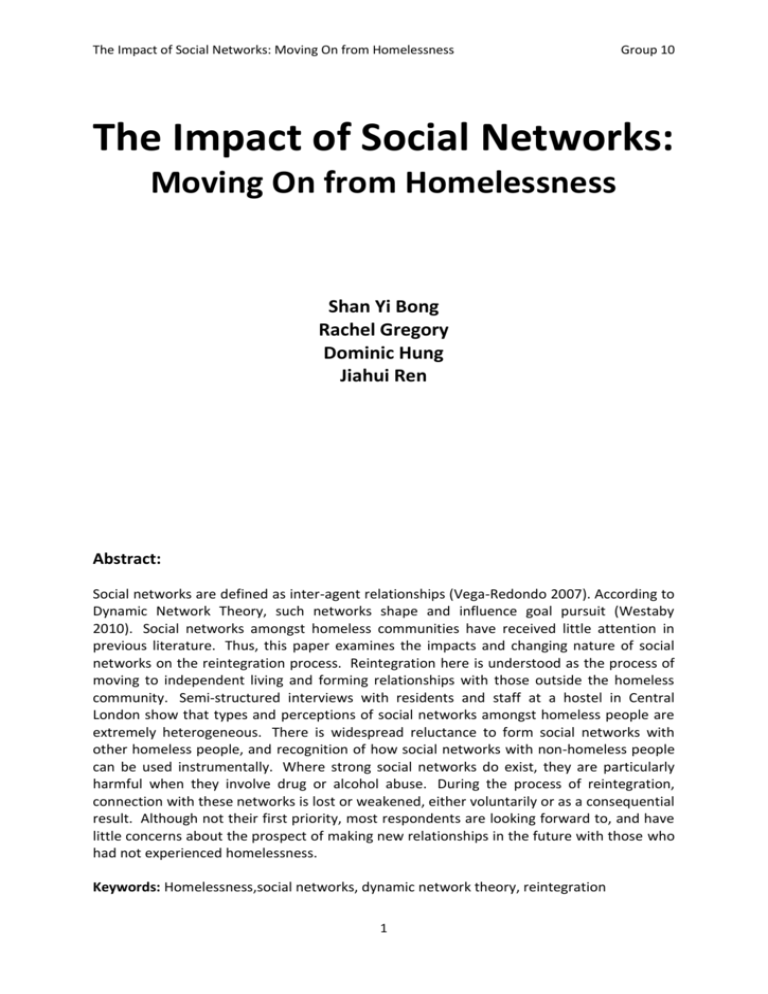
The Impact of Social Networks: Moving On from Homelessness Group 10 The Impact of Social Networks: Moving On from Homelessness Shan Yi Bong Rachel Gregory Dominic Hung Jiahui Ren Abstract: Social networks are defined as inter-agent relationships (Vega-Redondo 2007). According to Dynamic Network Theory, such networks shape and influence goal pursuit (Westaby 2010). Social networks amongst homeless communities have received little attention in previous literature. Thus, this paper examines the impacts and changing nature of social networks on the reintegration process. Reintegration here is understood as the process of moving to independent living and forming relationships with those outside the homeless community. Semi-structured interviews with residents and staff at a hostel in Central London show that types and perceptions of social networks amongst homeless people are extremely heterogeneous. There is widespread reluctance to form social networks with other homeless people, and recognition of how social networks with non-homeless people can be used instrumentally. Where strong social networks do exist, they are particularly harmful when they involve drug or alcohol abuse. During the process of reintegration, connection with these networks is lost or weakened, either voluntarily or as a consequential result. Although not their first priority, most respondents are looking forward to, and have little concerns about the prospect of making new relationships in the future with those who had not experienced homelessness. Keywords: Homelessness,social networks, dynamic network theory, reintegration 1 The Impact of Social Networks: Moving On from Homelessness Group 10 1. Introduction: There has been a 19% increase in the number of rough sleepers in London from 2008/9 and 2009/10 (St Mungo’s 2010). Organisations such as St Mungo’s, Shelter and many other organisations have been providing direct help and advice to homeless people. The reintegration process includes both financial and social aspects. However, there are barriers, be they personal health issues or regulations, which may delay the receipt of help or even make reintegration impossible. Among these barriers, social networks, inter-agent relationships that include more than friendships (Vega-Redondo 2007), remain a rather unexplored area in social science research. This study intends to look at the social networks that develop while rough sleeping, moving into hostels, and eventually becoming independent, how these networks change and impact upon the processes of reintegration. Perspectives and accounts captured through semi-structured interviews with former rough sleepers and staff at a homeless hostel, give a clearer picture of the issue of homelessness, shining light on barriers often overlooked they face when trying to move on. 2. Methodology: The qualitative research design employed in this study reflects the inductivist approach undertaken (Bryman 2008). Exploring a relatively untapped area of research, the aim of this study is to understand and capture processes and subjective perceptions. Qualitative methods were chosen to capture the rich detail required to do this. Interviews were conducted with residents from homeless hostels1. Interviewing hostel residents, rather than rough sleepers, has several advantages. Firstly, ethical considerations render it inappropriate to approach rough sleepers in their ‘home’, the street. Secondly, it is not possible to ascertain that potential participants are in a suitable state to give informed consent and to ensure researchers’ safety. Furthermore, hostel residents have begun the process of reintegration, giving the opportunity to analyse the ways social networks are currently influencing participant’s reintegration. Rough sleepers may not have been given this opportunity yet, which is likely to play a bigger role in preventing reintegration than social networks in this case. In the hostel environment, it was also possible to interview staff members who had experienced homelessness themselves, and were able to give a more encompassing view on the entire reintegration process. Nevertheless, an important consideration in only interviewing hostel residents is that this restricts the sample to those whose social networks have not prevented them from making the first step in the integration process. Despite approaching several hostels, only one was willing to grant access to their residents. As a result, it was not possible to use a desired range of data sources and locations. Additionally, interviews could not be pre-arranged due to the reliability of residents and hostel administrative constraints. Due such difficulties in accessing potential participants, a convenience sampling has been used. Because of the qualitative nature of 1 Ideally, to answer the research questions posed, interviews would have been conducted with both those that have reintegrated successful and those who have not. This would have given a complete understanding of the role social networks play in both scenarios. 2 The Impact of Social Networks: Moving On from Homelessness Group 10 the study and limited time frame, the final sample is relatively small. Nevertheless, this is appropriate for the research design, which focuses on emerging theory, not statistical adequacy. In total, eight interviews were conducted, five with current residents and three with staff members, two of whom had formerly been homeless. Semi-structured interviews were used to achieve a balance between consistency and depth of response, allowing for necessary prompting. Interviews were recorded to reduce memory bias and avoid distracting participants with note-taking. To try and minimise respondent bias leading questions to impose interpretations of participant’s goals were avoided and. Unfortunately, due to risk assessment requirements most interviews were conducted in communal spaces. As a result, there was some disturbance and potentially some respondent bias remains. Interviews ranged from ten minutes to an hour. To analyse this data thematic analysis was used (Bryman 2008); this approach allowed for common and dissimilar themes and subthemes to be explored in a matrix, helping explore the processes and different stages involved in the reintegration process. 3. Literature Review: Within the existing homeless literature there has been little research conducted on the friendship networks of homeless people (Fitzpatrick et. al 2000). Most research and policy to tackle homelessness largely focuses on economic influences. Economic outcomes, such as attaining a job or living independently are used as a measure of social reintegration. ‘Homelessness in England’, providing background on policy for the British Government, identifies “the overall supply of affordable housing in England” as a key factor in combating homelessness (Wilson 2013:2). However, Wilson (2013) also admits that “overall, we know relatively little about the personal, social and economic circumstances of homeless families”. The paper, as a result, fails to put forward any substantive knowledge or guidance to tackling homelessness on a social front. Our paper criticises such an approach, because according to ‘Dynamic Network Theory’, networks shape and influence goal pursuit (Westaby 2010). Therefore, social networks and ‘personal factors’ are critical in both causing and also in achieving reintegration for homeless people, and these should not be ignored. An example of existing research conducted by the Joseph Rowntree Foundation in ‘Tackling homelessness and exclusion: Understanding complex lives’, argues “the existence of positive social networks and relationships that are flexible, supportive and continuous is critical to addressing ‘Multiple Exclusion Homelessness’” (McDonagh 2001:15). Despite this, the author fails to provide any substantive information regarding the underlying factors that contribute to the development of such positive social networks, or how they may emerge. The basis of any social network of a homeless person at any point in time of his or hers homeless career, whether positive or negative, remains unexplored. Additionally, existing literature largely focuses on the impact of loneliness and isolation experienced by homeless people, and how these “represent a major limitation on their reintegration” (Tosi 2007:188). For example, research by Blake et al. (2008:77) showed that “homeless people were concerned about making new friends [...] the result is that many homeless people are lonely”. Despite this focus on the absence of social networks, Wasserman (2010) argues that there is a community on the street and that homeless people depend on these friendships more because they lack other resources. These relationships 3 The Impact of Social Networks: Moving On from Homelessness Group 10 offer practical and emotional support (McCabe et al. 2001), and do not end when entering shelters (Wasserman 2010). The relative scarcity of research on the social networks that do exist between homeless people, and the reasons why some may choose not to partake in such a community, provides an opportunity for these issues to be explored in this paper. 4. Results: This section considers the social networks participants identified at different stages of the reintegration process. Our analysis is structured as follows: firstly, this paper look at the background of our participants backgrounds, goals and previous relationships. Then we turn to the relationships that were developed and maintained whilst rough sleeping, during the time in the hostel and lastly we consider future relationships that have formed once people move on from a state of homelessness. 4.1 Participant’s Background: A diverse group of participants was interviewed, varying in age, sex and length of time spent rough sleeping and in hostels. Homelessness normally results from the culmination of multiple problems (Regan and Neuburger 2005). During the interviews a variety of personal issues came to light. In some cases these factors had contributed to the causes of their homelessness, in others these developed whilst homeless. Therefore, when reviewing the findings it is important to consider that the participants were extremely heterogeneous, facing various personal issues, which can also act as barriers to reintegration. Figure 4.1: Personal issues Theme: Sub-theme: Family Issues Divorce D Domestic Violence A Learning disabilities C Depression B Loss of partner D Loss of parents G Mental Health Issues Bereavement Substance abuse Participant: Alcohol A, G Narcotics E, G 4 The Impact of Social Networks: Moving On from Homelessness Group 10 4.2 Goals: To avoid interviewer bias, participants were asked about their ‘hopes for the future’, rather imposing assumptions. In response to this question, moving to their own residence was mentioned first by all but one participant. Only Eddie stated that he had no aspirations, however he had been diagnosed with cancer. The hostel's deputy manager highlighted that many residents did not regard the hostel as ‘home’. Career aspirations were also common, and three participants spoke of a desire to partake in voluntary or care work. For two of these it was motivated by wanting to help others in similar situations; whereas for one retired respondent, Dave, it was to “keep busy”. Of the four residents who had lost or reduced contact with their family, both female participants expressed wishes to see their children more or regain custody. This was expressed as one of their biggest hopes. Respondents only mentioned forming new friendships when prompted, and it appeared to be of low priority to them. Figure 4.2: Goals Theme: Sub-theme: Home Own flat Participant: A, B, C, D Continue to live in hostels Career Get a job B, C Take a college course Voluntary Work To help others No goals A B, F To keep themselves occupied Relationships E B Reconnect with family A, C Make new friendships A, C Living day-by-day E 4.3 Previous Relationships: Three participants spoke of relationships with family or friends that had persisted through homelessness. In two cases homelessness had been the result of lost relationships, for most friends and family had been able to help but eventually unwilling to do so. For Anne, this was because her family had also become homeless, and her friends also had “their own issues going on”. For Brian, help had been offered initially but subsequently exhausted. “You can only put up with stuff so long” – Brian 5 The Impact of Social Networks: Moving On from Homelessness Group 10 However, he was still in touch with his family, and had been offered work by one of his friends once he was “back on his feet”. Dave also spoke of friendships from before, however being homeless had made these difficult to maintain. “It’s [pause] it’s not so much hard [to get in touch] but sort of, oh… when visiting to start with it’s all very one-sided because not many visitors here[the hostel] and I wouldn’t like to invite them here anyway, so, it’s always visiting is always one-way and once again my own place so that we can be a bit more, reciprocate a bit more.” – Dave Figure 4.3: Relationships before homeless Theme: Sub-theme: Participant Did not offer support Not in a position to help Also homeless Had their own issues Did offer support A, C A Support exhausted B Offered work B 4.4 Relationships Developed and Maintains Whilst Rough Sleeping: Relationships while rough sleeping display three main patterns: social isolation, development of limited networks and development of full networks. Four participants experienced isolation on the street. For Anne, this was as a result of an abusive relationship, whereby her husband forbade her from initialising any other social bonds. For the others isolation was a conscious choice. They commonly expressed a lack of trust and suspicion of other homeless people. “In my experience people on the street either lied, robbed or blagged” – Fiona Despite his relative isolation sometimes connections were formed when considered beneficial. For example, Brian noted one emotional supportive friendship with a man who encouraged him to move on from rough sleeping as quickly as he could. One participant with a more extensive social network, Dave, considered the bonds to be weak and merely a consequence of shared space. He viewed his ‘acquaintances’ only as people to spend some time with. As a former soldier he felt he was capable of fending for himself. “No, I wouldn’t say friendships - acquaintances, yeah, but no, no real friendships yeah.” – Dave Eddie and Gary were the only participants to describe involvement in a strong social network, both of which had developed around drug use. Both identified their former 6 The Impact of Social Networks: Moving On from Homelessness Group 10 networks as unhealthy and had lost contact with them. Friendship and camaraderie regularly alternated with hostility and violence, with deaths not uncommon amongst agents of these networks. “So one minute, you’d be swearing your undying love for a pal on the street and the next minute he could have a knife at your throat.” – Gary Upon, entering the hostel such networks gradually decline in influence. This is due to “drifting” because of distance or divergent interests. In Brian’s case this was the effect of deliberate actions of the part of their networks to help him progress. “He wouldn’t give me like a number, er he said I knew where he’d be around the West End. I saw him occasionally, but not for a while.” – Brian Whereas for Gary, this was because of the treatment he undertook to move forward which alienated his former networks. Figure 4.4: Relationships when rough sleeping Theme: Sub-theme: (Characteristics) Isolation Independence D Lack of trust C Safety F Avoid trouble B Abuse A Encouragement and understanding B Avoiding loneliness D Weak Network Strong Network Participant: Occasional friendship and camaraderie E, G Harmful; drug and alcohol abuse E,G Dysfunctional; danger from other agents in network Not real friends despite occasional warmth G E, G 4.5 Relationships Developed and Maintains Whilst in the Hostel: All participants were able to highlight change in their social networks upon entering the hostel. For most this constituted an expansion. 7 The Impact of Social Networks: Moving On from Homelessness Group 10 “Yeah, lots of new friends. Both boys and girls” – Anne However, four participants were still reluctant to form new relationships, referring to a lack of trust and a wish to concentrate on their own recovery. “Basically I keep myself to myself... cause I just want to sort my life out, get my kids back.” – Cathy Brian expressed a similar sentiment, but said that he did form new relationships at first to learn about hostel life, but then chose not to maintain them. Views about whether these new relationships were supportive to participant’s reintegration process were mixed. Networks in the hostel exhibited many of the same characteristics as those formed on the street, and temptation was present. “…so I moved to a wet house where I was given a roof over me but I was able to drink so one problem of homelessness was taken care of but I brought the streets with me into the wet house” – Gary However, other respondents felt their new networks were different to those when rough sleeping and offered them more support. [Speaking about friendships in the hostel] “Yeah, yeah, yeah, genuine ones this time. Real ones yeah.” – Eddie There was also mixed views on whether these relationships would be maintained upon leaving the hostel. Anne was sure she would keep in touch once she was living independently. However, Fiona was careful not to divulge her new address for fear other hostel residents would cause trouble for her once she moved on. However, Gary had maintained close contact with some of the people he’d met whilst in recovery, forming close bonds of common experiences. “Yeah, some of them become lifelong friends.” – Gary New networks in the hostel also involved support staff. Most participants agree these relationships were supportive in their reintegration process, providing both physical and emotional support. “No actually they’re really good cause…they er got me a cleaner in my room…and he cleans my room and that’s good” – Eddie “And they give you solutions…and they remind you that your friendships were actually unhealthy for you at that time” – Gary 8 The Impact of Social Networks: Moving On from Homelessness Group 10 Figure 4.5: Relationships in the hostel Theme: Sub-theme: Residents Different Participant Expansion Genuine E, G Supportive Shared goals G Instrumental To settle in B To avoid loneliness D Reluctant to form Staff A To focus on own progress B, C, F Didn’t share goals F Independent D Supportive A, B, C, E, G 4.6 Future Relationships: When asked about the prospect of forming future relationships most respondents were keen to do so and not daunted by the prospect of this, often justifying this with past popularity. “No, I had lots of friends at school” – Ann “I’m generally not very shy, so I do find it easy to make [new relationships], and I love people!” – Gary Dave placed less value on friendships than other participants, seeing them as a way to pass time but not wholly necessary to his functioning. “I should think there’s nothing worse than just being stuck on your own with no one at all, but, as I said, I keep in touch with some.” – Dave Furthermore, Cathy did not see making new friendships as a priority, and expressed a lack of trust that made her want to focus on herself rather than form new relationships with others. “Yeah… I don’t really you know have a problem with mixing with other people. It’s just what I’ve been through; it gets me not to trust people.” – Cathy Of the two formerly homeless staff members both stated that they had formed lots of new friendships since leaving homelessness, and that their past experiences were not problematic for them. 9 The Impact of Social Networks: Moving On from Homelessness Group 10 “Yeah lots [of new friends]”, “No it [past experience of homelessness] wasn’t a problem” – Fiona However, Gary described various reactions he received to his past life and said that he normally chooses not to divulge too many details. He had mentioned that first that it was none of others people business, although this in turn might have been motivated by a fear of rejection. “Although I don’t share intimate detail, I don’t normally share the content to the people I meet but urm some are horrified by what you’ve experience, some are impressed.” – Gary “Trying to reintegrate, I never confessed to being, er, an alcoholic.” – Gary Gary also spoke of the difference between his relationships before and after his reintegration, and the importance some of these relationships played in his recovery. “That shared experiences that we continue to share with each other that helps us gain more strength in our recovery but also helps out recovery gain more resilience.” – Gary Figure 4.6: Forming New Relationships Theme: Sub-theme: Participant: Not a priority Lack of trust C Not worried about it Perceived themselves as sociable Not a problem that they have different experiences Different type of relationships A, B, G F, G Healthier G Emotional support G Important to avoid loneliness D 5. Discussion: The variety of responses obtained means there is no common form of social networks for all homeless individuals. However, there are common themes that emerge. Firstly, networks did not remain constant for any participant, and even the nature of their networks changed dramatically during their homeless careers. People entered and left the networks over time – however, the magnitude of change is greater than for those who have not experienced homelessness. This change manifests in the form of street acquaintances to social workers and friendships formed on shared goals. Participants value relationships developed at 10 The Impact of Social Networks: Moving On from Homelessness Group 10 different stages of their homeless careers differently. This perception of value reduces the importance of street networks, as there is little to no emotional weight, and this value is reduced further as perspectives change to focus on the prospect of moving out of homelessness. The interviews offer some explanation to why the social networks develop in these ways. Participants who have no or weak social networks seem to choose to isolate themselves, because of safety concerns or lack of trust. However, these participants also expressed wishes to form friendships in the future and maintain friendships from before they were homeless. This suggests it is not lack of sociability, but the perception of others in homeless state or their own vulnerability in this state. Instrumental use of networks was common. Networks were used to gain information or access resources, to help settle or move to the next state of the reintegration process. A significant number of participants chose to keep to themselves while rough sleeping and living in the hostel. Hence, the impact of their networks was limited. Looking at the more sociable participants, we find street relationships tend to be unsupportive as mentioned by Eddie and Gary. However, there are cases where emotional support is received from other rough sleepers, for example in Brian’s case. Amongst these participants supportive relationships tend to exist amongst those with smaller networks, who were more cautious about developing relationships. However, it is difficult to determine the causality of this without further research. Relationships with staff at the hostel are perceived as helpful, and those who partake in training courses tend to have supportive relationships with other attendees. Although, social networks do impact upon participants’ ability to reintegrate, many other factors are also important. Amongst those identified were self-determination, personal characteristics and council decisions. Figure 5.1: Other factors Theme: Sub-theme: Positive Self-determination Participant A, B, C, E, F, G, H Professionals Doctors E Lawyer C Support workers Courses and support groups Skills Colleagues Mind-set 11 A, E, G A, B, C, D, G, H B, H F The Impact of Social Networks: Moving On from Homelessness Group 10 Figure 5.2: Other factors Theme: Sub-theme: Negative Pride Participant D, F, H Drug Use E, G Professionals Doctor B Personal Characters Negative attitude F Anti-social behaviour F Anger management E Housing Other residents Council Life on the street becomes normal F, G, H D B, E Finally, homelessness breaks a person’s links with normal society, as they are perceived as ‘undesirable’ and subsequently removed from the public sphere (Edgar et al. 2002). Despite the experience of stigma, none of the participants were daunted by the prospect of social reintegration into society. Both participants, Gary and Fiona, who had moved on from homelessness and now worked at the hostel have successfully achieved social reintegration, but this is unlikely to be representative. Since the participants currently residing in the hostel have not yet reached this stage, it is impossible to determine whether their confidence is justified. 6. Conclusion: This study looks into the social networks developed while rough sleeping, moving into hostels, and eventually becoming independent. It considers how these networks change and impact upon the process of reintegration. Our analysis has shown that social networks do change dramatically between stages of reintegration. It demonstrates that street networks tend to be less valued and harmful, while networks formed later tend to be more emotionally supportive, regarded as more important or instrumental and healthier. Despite these common trends, both the composition of networks and perceptions about them vary between respondents. Due to individual concerns and characteristics, the impacts of these networks are heterogeneous. These findings offer new insights into the complex role social networks play in the reintegration process. Although, the findings are not definitive, they allow another layer of the barriers that can prevent reintegration to be considered. Hence, informing a more holistic understanding of how homeless people may be helped move on from the homeless state. 12 The Impact of Social Networks: Moving On from Homelessness Group 10 Despite this, further research is needed as this analysis does not capture rough sleepers, and therefore ignores the possibility strong social networks may even prevent the first stage of reintegration, entering the hostel. Furthermore, this research is based on perceptions of the likely impact of current networks on the future. By conducting a longitudinal comparison, through follow-up interviews as each participant progresses further through the reintegration process, the actual impacts of social networks could be established with more certainty. 13 The Impact of Social Networks: Moving On from Homelessness Group 10 7. Bibliography: Blake, S. et al. (2008) ‘Lost property: Tackling homelessness in the UK’, New Philanthropy Capital. Accessed 03/07/13 from: http://www.thinknpc.org/publications/lost-property/lostproperty-full/?post-parent=4979 Bryman, A. (2008) Social Research Methods, Oxford University Press: Oxford. Edgar et al. (2002) Access to housing: Homelessness and Vulnerability. Fitzpatrick et al. (2000) Single Homelessness: An Overview of Research in Britain, The Policy Press: Bristol. McCabe, S. et al. (2001) ‘Homeless patient's experience of satisfaction with care’, Archives of Psychiatric Nursing, 15(2), 78-85. McDonagh, T. (2011) ‘Tackling homelessness and exclusion: Understanding complex lives’, Joseph Rowntree Foundation Accessed 03/07/13 from: http://www.jrf.org.uk/sites/files/jrf/homelessness-exclusionservices-summary.pdf Regan and Neuburger (2005) ‘Homelessness’, in Preston, G. (ed.) (2005) At Greatest Risk: the children most likely to be poor, London: Child Poverty Action Group St Mungo’s (2010) Homeless people face cold cuts ahead, warns St Mungo’s highlighting the worrying trend of rough sleeping numbers rising Accessed 03/07/13from: http://www.mungos.org/press_office/727_homeless-people-facecold-cuts-ahead-warns-st-mungo-s-highlighting-the-worrying-trend-of-rough-sleepingnumbers-rising Tosi, A. (2007) ‘Re-housing and social reintegration of homeless people’, Innovation: The European Journal of Social Science and Research, 18(2), 183-203. Accessed 03/07/13 from: http://www.tandfonline.com/doi/pdf/10.1080/13511610500096525 Vega-Redondo, F. (2007) Complex Social Networks, Cambridge University Press. Wasserman, J. A. (2010) At Home on the Street, Lynne Reinner Publishers Inc. Westaby, J. D. (2010) Dynamic Network Theory, American Psychological Association. Wilson, W. (2013) ‘Homelessness in England’, Social Policy Section. Accessed 03/07/13 from: http://www.parliament.uk/briefing-papers/SN01164.pdf 14
